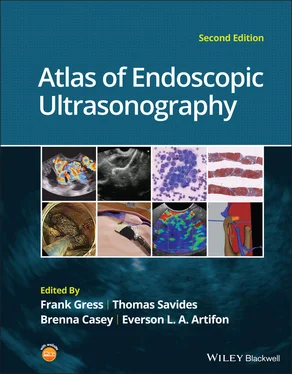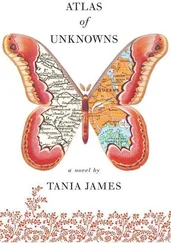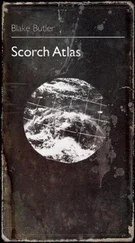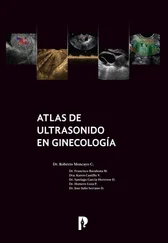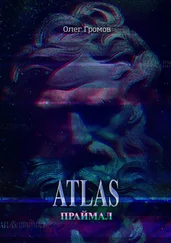Atlas of Endoscopic Ultrasonography
Здесь есть возможность читать онлайн «Atlas of Endoscopic Ultrasonography» — ознакомительный отрывок электронной книги совершенно бесплатно, а после прочтения отрывка купить полную версию. В некоторых случаях можно слушать аудио, скачать через торрент в формате fb2 и присутствует краткое содержание. Жанр: unrecognised, на английском языке. Описание произведения, (предисловие) а так же отзывы посетителей доступны на портале библиотеки ЛибКат.
- Название:Atlas of Endoscopic Ultrasonography
- Автор:
- Жанр:
- Год:неизвестен
- ISBN:нет данных
- Рейтинг книги:4 / 5. Голосов: 1
-
Избранное:Добавить в избранное
- Отзывы:
-
Ваша оценка:
- 80
- 1
- 2
- 3
- 4
- 5
Atlas of Endoscopic Ultrasonography: краткое содержание, описание и аннотация
Предлагаем к чтению аннотацию, описание, краткое содержание или предисловие (зависит от того, что написал сам автор книги «Atlas of Endoscopic Ultrasonography»). Если вы не нашли необходимую информацию о книге — напишите в комментариях, мы постараемся отыскать её.
Atlas of Endoscopic Ultrasonography Atlas of Endoscopic Ultrasonography, Second Edition
Atlas of Endoscopic Ultrasonography, Second Edition
Atlas of Endoscopic Ultrasonography — читать онлайн ознакомительный отрывок
Ниже представлен текст книги, разбитый по страницам. Система сохранения места последней прочитанной страницы, позволяет с удобством читать онлайн бесплатно книгу «Atlas of Endoscopic Ultrasonography», без необходимости каждый раз заново искать на чём Вы остановились. Поставьте закладку, и сможете в любой момент перейти на страницу, на которой закончили чтение.
Интервал:
Закладка:
Right lower paratracheal nodes (station 4R): the upper border is the innominate vein, the lower border is the azygos vein. This station is usually found just proximal to the main carina, between 12 and 3 o’clock.
Left lower paratracheal nodes (station 4L): the upper border is the superior limit of the aortic arch, the lower border is superior limit of the left pulmonary artery. This station is usually found at the level of the main carina, left lateral wall of the trachea, at 9 o ‘clock. The view of the AP window is very similar to that seen by the EUS scope with the aortic arch on the right and pulmonary artery on the left.
Subcarinal nodes (station 7): the upper border is the main carina, the inferior border is the superior limit of the left lower lobe take‐off on the left side, and the inferior limit of the bronchus intermedius on the right side. This station is found at the medial wall of the left mainstem bronchus or the medial wall of the right mainstem bronchus and bronchus intermedius.
Right hilar nodes (station 10R): the upper boder is the azygos vein, the lower border is the interlobar region. This station is usually found just proximal to the right upper lobe take‐off, facing to the anterior and lateral airway wall.
Left hilar nodes (station 10L): the upper border is the pulmonary artery, the lower border is the interlobar region. EBUS scope should be faced just proximal to the left upper lobe, at 11 o’clock.
Right interlobar superior nodes (station 11Rs): the upper limit is the right upper lobe bronchus, the lower limit is the distal bronchus intermedius. This station should be found at the lateral wall of the airway, between 2 and 4 o’clock.
Right interlobar inferior nodes (11Ri): lymph nodes are between the right middle lobe and the right lower lobe. EBUS scope should be placed just proximal to the right lower lobe bronchus, facing laterally.
Left interlobar nodes (station 11L): the upper limit is the left upper lobe bronchus, the lower limit is the left lower lobe bronchus. Place EBUS scope at the left lower lobe take‐off, facing anterior and lateral.
Right/left lobar nodes (station 12R/L): any lymph nodes adjacent to the lobar bronchi.
Complications and safety
EUS‐FNA and EBUS‐TBNA are highly safe procedures in experienced hands, with a complication rate of 0.8%. A major safety precaution with FNA is to visualize the entire length of the needle and to use color Doppler to avoid any blood vessels in the needle path.
Conclusions
EUS‐FNA and EBUS‐TBNA are complementary procedures with a high degree of sensitivity and specificity for diagnosing and staging benign and malignant diseases of the chest. Careful attention to technique must be applied to prevent the omission of important clinical information.
Chapter video clips
Video 3.1.1 Normal mediastinal anatomy by linear EUS: vascular anatomy. Source: Hitachi.
Video 3.1.2Normal mediastinal anatomy by linear EUS: right and left atrium and AP window. Source: Aloka.
Video 3.1.3 Normal mediastinal anatomy by linear EUS: aorta, heart and great vessels. Source: Hitachi.
Video 3.2 Normal mediastinal anatomy by radial EUS.
Video 3.3 Paratracheal and subcarinal lymph node evaluation by EBUS. Source: Hitachi.
Video 3.4 Subcarinal lymph node (station 7) as seen by EBUS with performance of FNA.
4 Stomach: Radial and Linear
Joo Ha Hwang
Stanford University, Palo Alto, CA, USA
Endoscopic ultrasound (EUS) examination of the stomach is often performed to evaluate subepithelial lesions, staging of mucosa‐associated lymphoid tumor (MALT) lymphomas, staging of gastric cancer, and evaluation of thickened gastric folds. Examination can be performed using mechanically scanning or electronic array echoendoscopes, or with ultrasound catheter probes.
The basic technique for performing EUS imaging of the gastric wall initially requires clearing the gastric lumen of any mucus or debris. The lumen should be thoroughly irrigated with water and suctioned. If there are excessive amounts of bubbles in the gastric lumen, a small amount of simethicone can be added to the irrigating water and suctioned. Once the gastric lumen has been cleared the gastric lumen should be decompressed and then filled with clean water. Ideally, degassed water should be used to fill the gastric lumen; however, this is often not available and clean water typically is sufficient. However, efforts should be made to minimize the presence of bubbles within the water as this will degrade the image quality. It is important to make sure that all air is aspirated from areas where imaging is to be performed. When filling the gastric lumen with the patient on their left side, the fundus and body will fill preferentially due to gravity. If the area of interest is in the antral wall, positioning the patient on their right side may be necessary to safely fill the gastric lumen with water for imaging. Filling of the gastric lumen with water places the patient at risk of aspiration; therefore, precautions should be taken to protect against an aspiration event.
After aspirating the air out of the lumen and distending the gastric lumen with water, the gastric wall can be surveyed with a radial scanning echoendoscope by starting the exam with the ultrasound probe in the antrum and slowly withdrawing the probe ( Figure 4.1). If only a focal area needs to be examined, the use of a water‐filled balloon can be used, especially for evaluating non‐mucosal lesions such as subepithelial tumors. However, the use of a water‐filled balloon creates an additional interface echo that impacts the image quality at the balloon–mucosa interface. Therefore, a water‐filled balloon should not be used to provide acoustic coupling to mucosal lesions.
It is also important to perform imaging within the focal region of the transducer. The mechanical radial scanning echoendoscopes and catheter probes have a fixed natural focus where the best image resolution is obtained. The focal distance can easily be determined by adjusting the distance of the transducer from the gastric wall. The best resolution will be seen when the area of interest is at the focus of the imaging transducer. Electronic array echoendoscopes (radial and curvilinear) have the ability to electronically adjust the location of the focal region; therefore, when imaging the gastric wall, the focal region should be adjusted accordingly.
For imaging superficial lesions, the use of a catheter probe through a double‐channel endoscope allows for visual guidance of probe placement. The use of a double‐channel endoscope allows for one channel to be used for the ultrasound catheter probe and the other channel to be used for injecting water into the gastric lumen and suctioning water and air from the gastric lumen. Ultrasound catheter probes are available in frequencies of 12, 20, and 30 MHz. The image resolution increases with increasing frequency; however, penetration (depth of imaging) decreases as frequency increases.
The stomach has a well‐developed five‐layered wall structure ( Video 4.1). This is easily visualized when water is placed in the lumen. The second layer is often prominent because of the relatively thick columnar mucosa and glands ( Figure 4.2). The fourth layer is often thicker in the distal stomach compared to the proximal stomach. The fifth layer generally corresponds to surrounding structures and perigastric fat as the serosa is too thin to be resolved with endoscopic ultrasound. EUS imaging of the gastrointestinal (GI) tract wall typically exhibits five layers; however, seven or nine layers can be resolved if imaging is performed at higher frequencies depending on the region of the GI tract being examined. Initial interpretation of the EUS images assumed direct correspondence of the layers seen on EUS to those seen on histology. It was presumed that the first echogenic layer represented the mucosa, the second echolucent layer the muscularis mucosae, the third echogenic layer the submucosa, the fourth echolucent layer the muscularis propria, and the fifth echogenic layer the serosa and subserosal fat. However, it was later proven that this was an incorrect interpretation of the EUS images of the GI tract wall. In fact, it was demonstrated that the five layers seen on EUS imaging correspond to the following ( Figures 4.2and 4.3).
Читать дальшеИнтервал:
Закладка:
Похожие книги на «Atlas of Endoscopic Ultrasonography»
Представляем Вашему вниманию похожие книги на «Atlas of Endoscopic Ultrasonography» списком для выбора. Мы отобрали схожую по названию и смыслу литературу в надежде предоставить читателям больше вариантов отыскать новые, интересные, ещё непрочитанные произведения.
Обсуждение, отзывы о книге «Atlas of Endoscopic Ultrasonography» и просто собственные мнения читателей. Оставьте ваши комментарии, напишите, что Вы думаете о произведении, его смысле или главных героях. Укажите что конкретно понравилось, а что нет, и почему Вы так считаете.
